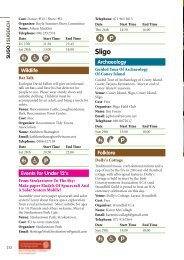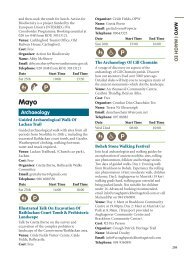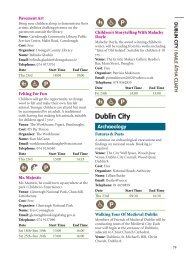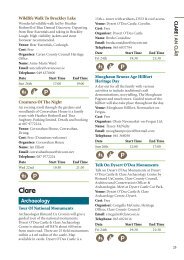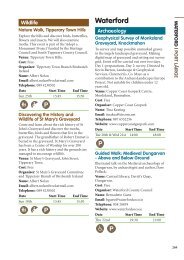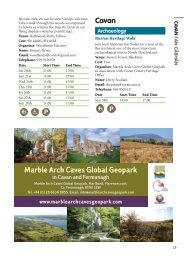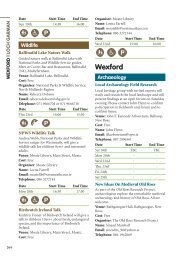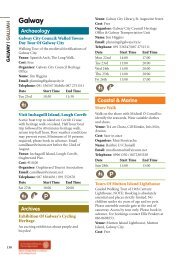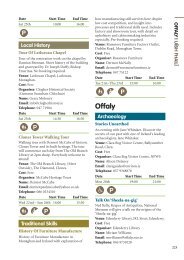10 Don'ts for Press Releases Writing a Press Release - Heritage Week
10 Don'ts for Press Releases Writing a Press Release - Heritage Week
10 Don'ts for Press Releases Writing a Press Release - Heritage Week
Create successful ePaper yourself
Turn your PDF publications into a flip-book with our unique Google optimized e-Paper software.
• It’s full of what Hazlitt called the ‘big, grey words of the lexicon’. If you sit in a bus and listen to<br />
ordinary people talking, you’ll listen a long time be<strong>for</strong>e you hear words like ‘infrastructure’ or ‘policy<br />
directive’.<br />
Headlines should always be in the language of the reader not the writer.<br />
• It’s passive. ‘Enabled by …’ is an indirect, passive way of saying something.<br />
• It’s in the past tense, so it sounds historic rather than newsy<br />
This is a good headline:<br />
New Road Cuts Traffic Jams In Half<br />
• It’s short. Tells the story in seven words<br />
• It’s in vivid simple language<br />
• It’s active: ‘Cuts traffic jams..’<br />
• It’s got human implications. (Most of us have been stuck in traffic jams.)<br />
• It’s in the present tense, so it’s newsy<br />
• (The future tense would work equally well: ‘New Road Will Cut Traffic Jams in Half’)<br />
• It’s imaginable. We can see traffic moving freely<br />
When you’re writing a headline, remember that there is no obligation on the reader to pay any attention to<br />
it. The obligation is on you to attract the reader. It’s pointless to say ‘but they should be interested in this’.<br />
There are no ‘shoulds’ in mass media. You have to attract and persuade people to read your story: they<br />
have a million and one alternatives. The onus is on the writer, not the reader. And that applies throughout<br />
the writing of your press release.<br />
2. A Good <strong>Press</strong> <strong>Release</strong> Answers the Key Questions in the First Paragraph<br />
Why<br />
For two reasons:<br />
• If you story gets into the paper, and another, bigger story comes along be<strong>for</strong>e it goes to print, they<br />
will edit your story. Under pressure, a sub-editor will simply chop off the end of it. So your story<br />
must be understandable, even if what follows the first paragraph were chopped off.<br />
• Readers are busy and distracted. They may not have the time to read every story to the end. So<br />
you want to deliver the key in<strong>for</strong>mation early, just in case.<br />
The key questions are:<br />
• What (is happening)<br />
• Who (is involved)<br />
• Where (is it happening)<br />
• When<br />
• Why<br />
3. A Good <strong>Press</strong> <strong>Release</strong> uses Active Verbs and First Degree Words<br />
This sentence uses the passive <strong>for</strong>m of the verb: ‘The town hall was occupied by protestors.’<br />
This sentence uses the active <strong>for</strong>m of the verb: ‘Protestors occupied the town hall.’<br />
Remember, if it’s a headline, don’t just go <strong>for</strong> an active verb, go <strong>for</strong> a present or future tense verb:<br />
‘Protestors Occupy Town Hall’ or ‘Protestors to Occupy Town Hall’<br />
Here’s the easiest way to remember this rule:<br />
• BAD: Man bitten by dog (passive, past tense)<br />
• GOOD: Dog bites man (active, present tense)<br />
FIRST DEGREE WORDS are the terms we automatically use:<br />
• Boat<br />
• Book<br />
• Face<br />
SECOND DEGREE WORDS are the terms we use when we want to be more varied or impressive:<br />
• Vessel<br />
• Volume/Tome<br />
• Countenance




